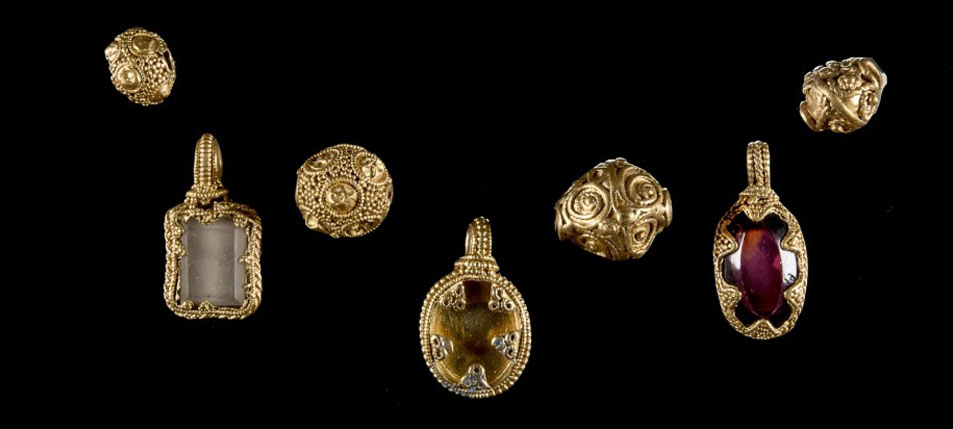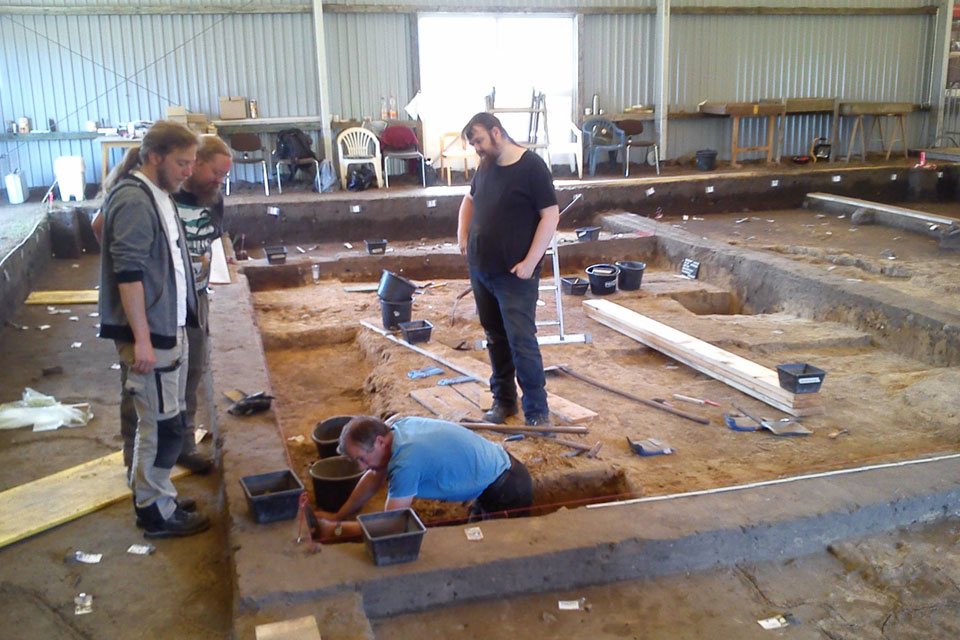This summer archaeologists excavate a burial ground from 10th century Haithabu. Spectacular finds may shed further light on the elite lifestyle of Vikings and the Danish connections between Haitahbu and the the Royal court at Jelling.
In 1939 archaeologists were digging at a burial ground at Haithabu, the Viking emporium on the ancient border between Germany and Denmark. The first excavations took place there between 1908 -1912 but did not yield much. Most of the 319 inhumations appeared to have been east-west orientated; also they did not, in general, contain grave goods.
However, a couple of graves stood out and led to further excavations in 1939. Helmer Salmo, who was responsible for this dig, was able to excavate no more than two graves, in one of which – grave no. 318 he found a medallion of gold missing its stone. Due to the war, however, the excavations were stopped, and no one has had the time – until now – to finish where they left off. For many years the wet conditions down by the harbour kept the archaeologists occupied as they have continued to yield fathomless spectacular finds.
This spring the archaeologists returned to the burial ground with its inhumations. The overall reason is that new technologies in the last decade have made it possible to study genetic as well as geographical heritage through the mapping of aDNA and isotopes. Hopefully, it will also be possible to establish the demographic profile of the population in Haithabu in the last part of the 10th century as well as its state of health and nutrition is expected.

Spectacular finds
Apart from this more mundane research some of the absolute highlights have been found in graves no. 318 and 319.
Already in 1939, the archaeologists were able to recover a sword from grave 319. Dated to c. 950 – 1000, this sword is remarkable in so far as it shows a distinct affiliation with England. The new excavations in 2017 have yielded part of the skull of this man. The archaeologists hope that it will be possible to determine whether he came from or at least had spent some time in England.
Next to this grave, no. 319, a woman had been buried. Again, only a few teeth have been found, but around Easter the real scoop surfaced: four golden pearls and two more medallions, one with an amethyst and another with rock-crystal. Together with the pendent found in 1939, the jewels constitute a magnificent necklace. Hopefully, a study of the fragments of human remains will offer us some information of who this couple was and where they came from (or had spent their life).

Parallels from Fæsted in Denmark
An interesting fact is that one of these pendants shows an uncanny likeness to another jewel found in connection with a treasure recovered from Fæsted near Vejen last year. Weighing up to 1.5 kilos and consisting of up to fifty pieces or fragments thereof, it also held several pendants one of which may have been made by the same artist as the new one from Haithabu. In December 2016, when archaeologists were evaluating the find from Fæsted, they speculated that it represented a gift from the presumed workshops at Jelling.
The new find at Haithabu seems to offer an alternative. The pendants might as well have been made at the emporium or even further south. Technically, it is the same type of granulated setting, which may be seen on, for instance, the Imperial Crown of the Holy Roman Emperor from the late 10th century and the so-called Gisela-schmuck from the end of the 10th century.
Careful studies of the two similar finds will hopefully tell us more about the date and the artistic and cultural context of the pendants from Haithabu as well as Fæsted.
Since April this year excavations in the inhumation burial ground of Hedeby are taking place in a cooperation between Centre for Baltic and Scandinavian Archaeology (ZBSA), Archäologisches Landesmuseum and Archäologisches Landesamt Schleswig-Holstein under the direction of excavation leader Dr Sven Kalmring (ZBSA).
The site of the excavation is open, and the museum invites guests to follow the archaeologists working. The excavations can also be followed on the dedicated FB-page: Ausgrabung Haithabu 2017
VISIT:
Wikinger Museum Haithabu
Am Haddebyer Noor 5
24866 Busdorf
Schleswig-Holstein
Germany
The Museum is closed for reinstallation until 2018. However, the open-air museum and the harbour is open for visits.
READ MORE:

